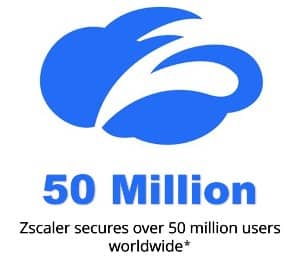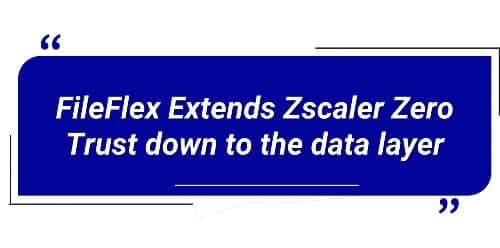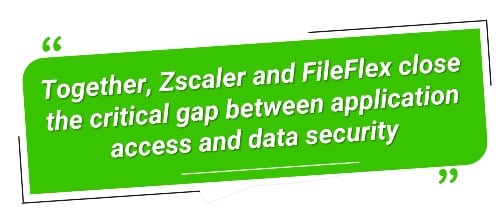
By combining Zscaler’s Zero Trust Exchange with FileFlex Zero Trust Data Access, organizations can secure both application access and the data within, achieving a complete end-to-end Zero Trust framework.
Achieving End-to-End Zero Trust with Zscaler and FileFlex
Estimated reading time: 3.5 minutes
Table of Contents
Introduction: Zscaler Secures Access, FileFlex Secures Data

Who is Zscaler?
Zscaler is a leading cloud security company that provides a Zero Trust Exchange platform, enabling secure access to applications and data from anywhere while protecting users, workloads, and devices against cyber threats. Its solutions replace traditional network security appliances with a scalable, cloud-native approach designed for modern hybrid and remote work environments.
What is Zscaler’s Product Offering?

- connecting users/devices/workloads directly to applications (not to the network) based on identity, context, posture, etc.
- continuously inspecting all kinds of traffic (including encrypted TLS/SSL) and stopping threats, data loss, lateral movement, etc.
- simplifying network/security stack by replacing many point products (VPNs, edge firewalls, appliances) with cloud‐delivered services.
Zero Trust Exchange is summarized as follows:
| Component | Value / Impact |
| User & Device Access (ZPA) | Replaces VPNs with secure, identity-based access to internal applications. Continuous posture checks (device compliance, MFA, SSO) ensure only verified users gain access. |
| Internet & SaaS Security (ZIA) | Provides a secure gateway to internet and SaaS with TLS inspection, firewall, CASB, sandboxing, and DLP, keeping users safe without exposing the corporate network. |
| Workload-to-Workload Security | Applies Zero Trust to cloud workloads (AWS, Azure, GCP) to prevent lateral movement and shrink attack surfaces between workloads. |
| Branch & IoT/OT Security (Zero Trust SD-WAN) | Uses identity-based policies for branch/factory connectivity. Extends zero trust to IoT/OT devices through segmentation and secure access. |
| Threat & Data Protection | Unified DLP, CASB, sandboxing, and phishing/malware defense across all traffic, protecting against ransomware, insider threats, and data leaks. |
| Visibility & Experience (ZDX) | Monitors application and network performance, latency, and policy enforcement to ensure Zero Trust does not degrade user experience. |
How FileFlex Zero Trust Data Access Complements Zscaler Zero Trust Exchange

| How They Work Together | Zscaler Contribution | FileFlex Contribution | Combined Value |
| Closing the Zero Trust Gap | Ensures only authorized users and devices can securely connect to applications. | Enforces file-level controls over what those users can do with the data once inside. | Extends Zero Trust end-to-end — from identity, to application, to data. |
| Data Protection Beyond the App | Blocks unauthorized access at the application and network layers. | Prevents sensitive data from being exposed via email, unmanaged file shares, or shadow IT. | Keeps data protected throughout its lifecycle, not just at the perimeter. |
| Stronger Ransomware Defense | Stops initial compromise and lateral movement within the network. | Prevents data exfiltration and enforces secure, auditable file workflows. | Creates layered protection that strengthens defense against ransomware and insider threats. |
| Regulatory & Compliance Alignment | Provides secure access and traffic inspection to support compliance. | Adds granular data governance, audit trails, and policy enforcement. | Delivers a comprehensive Zero Trust posture aligned with industry regulations. |
In short, Zscaler secures access to applications. FileFlex secures access to the data inside them. Together, they deliver a comprehensive Zero Trust security posture that extends protection from the network and application layer all the way down to the data itself.
Conclusion: Achieving End-to-End Zero Trust with Zscaler and FileFlex
By combining Zscaler’s Zero Trust Exchange with FileFlex Zero Trust Data Access, organizations can achieve a truly end-to-end Zero Trust security posture. Zscaler ensures that only authorized users and devices reach applications and networks, while FileFlex enforces granular, file-level controls over sensitive data wherever it resides. Together, they provide comprehensive protection against cyber threats, strengthen ransomware defenses, prevent data exfiltration, and support regulatory compliance. This integrated approach bridges the gap between application access and data security, empowering businesses to collaborate safely and confidently in today’s hybrid, cloud-first environments.
For related blogs on how FileFlex closes the data security gap see Extending Cisco Zero Trust from Access to Data, Extending Microsoft Entra to Protect Your Data with Zero Trust Data Access, Top Reasons to Add Zero Trust Data Access to Palo Alto Cybersecurity, How to Build a Complete Zero Trust Security Framework, and How to Enforce Zero Trust Access Control to Mitigate Data Breach and Ransomware.
Learn More About FileFlex Sign Up for a Free TrialFrequently Asked Questions
1. How does Zscaler contribute to a Zero Trust framework?
Zscaler secures access at the application and network layer through its Zero Trust Exchange, ensuring only authorized users and devices connect while blocking lateral movement of threats.
2. What role does FileFlex play in Zero Trust security?
FileFlex extends Zero Trust down to the data layer, applying file-level controls that protect sensitive data across on-premises, cloud, and hybrid environments, even after users gain access to applications.
3. Why combine Zscaler and FileFlex solutions?
Zscaler governs who can securely reach applications, while FileFlex governs what those users can do with the data inside them. Together, they close the critical gap between application access and data security, delivering true end-to-end Zero Trust.
4. How does this joint approach help with compliance and ransomware defense?
Zscaler provides secure access and traffic inspection to meet compliance needs, while FileFlex adds granular governance, audit trails, and secure file workflows—creating layered protection that strengthens ransomware defense and supports regulatory alignment.